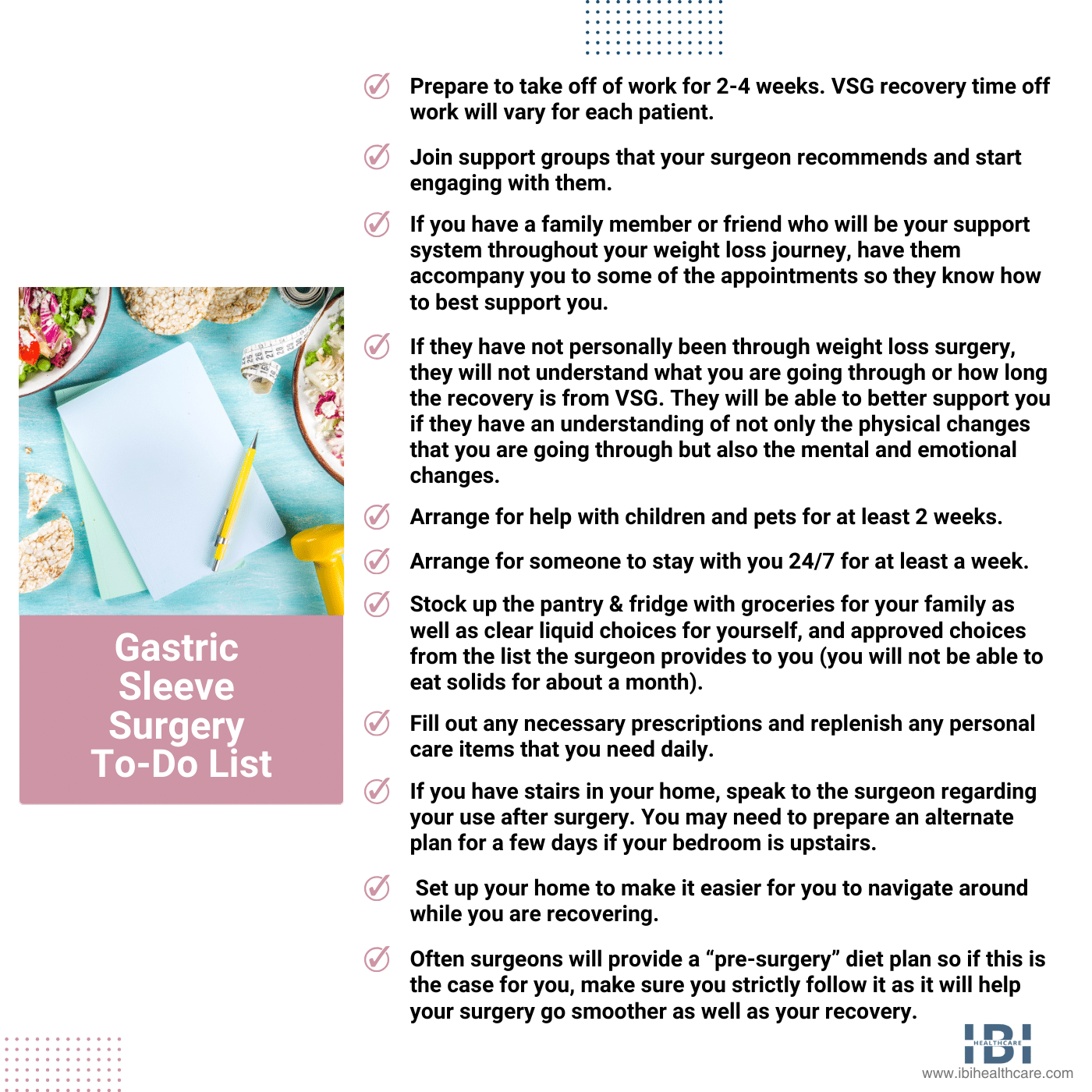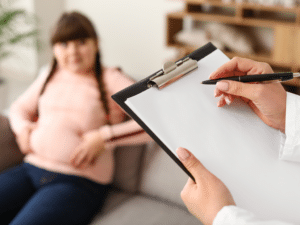Are you considering gastric sleeve (VSG) surgery? As with any surgery, recovery from gastric sleeve surgery is unique for each patient. It is important to understand not only the requirements for surgery but also what is going to happen after surgery and during the VSG recovery process. To ensure your recovery goes as smoothly as possible it is always good to plan and be prepared.
What is Gastric Sleeve Surgery?
Explore the benefits of gastric sleeve surgery (VSG) – a highly effective procedure removing 70-80% of the stomach to promote significant weight loss. Ideal for those with a BMI over 40 or weight-related health issues.
Laparoscopic Gastric Sleeve, also known as LSG, is a minimally invasive weight loss procedure performed by making small incisions in the patient’s abdomen. This surgery, which requires general anesthesia and a hospital stay of 1-3 days, effectively reduces the size of the stomach. By doing so, it limits calorie intake and creates a sensation of fullness, reducing hunger. LSG is the most popular and least invasive option among Bariatric Weight Loss Surgeries.
Preparing For Recovery From Gastric Sleeve Surgery
When returning home after your sleeve gastrectomy surgery, it is crucial to prepare both yourself and your surroundings. Even mundane tasks that you typically take for granted may become challenging during the initial stages of recovery. This includes activities such as grocery shopping, walking the dog, using stairs, and looking after your children.
Make sure to arrange for someone to drive you home from the hospital. You won’t be able to drive for about two weeks until your pain medications are stopped and your incisions start healing. This means you won’t be able to handle carpool duties or take your energetic dog for a walk immediately after surgery.
Plan for assistance during the first week post-surgery. By adequately preparing for your laparoscopic sleeve gastrectomy recovery, you can rest and heal more efficiently.

Gastric Sleeve Recovery Timeline
Day 1 – Surgery Day
After surgery, you’ll spend a few hours in the recovery room with an IV in your arm. Pain is normally moderate on this first day but well controlled through the IV medication. There will be several small incisions on your abdomen that have been closed with stitches and covered.
Some patients experience nausea caused by the anesthesia used during the surgery but this normally dissipates within the first few hours. Your throat may be sore and feel scratchy from the breathing tube that was necessary during surgery.
You will not be allowed to drink anything until the next day but some surgeons allow patients to have ice chips.
After being in the recovery room for a few hours, your surgeon may want you to get up a walk a little bit. This is not easy for most people but is necessary to prevent future complications. You will be transferred from the recovery room to a hospital room to spend the night.
Day 2 – The Day After Surgery
Stay hydrated during your recovery from bariatric surgery by following these guidelines. First, you will undergo a swallow test administered by a radiologist to check for any leaks in your stomach. Typically done in the morning, a clear result from this test will permit you to drink water. Additionally, your surgeon may approve other liquids like clear broth and unsweetened juice. While it’s crucial to avoid dehydration, it is equally important to drink slowly and avoid carbonated or caffeinated drinks. Remember that dehydration is a frequent cause of readmission, so prioritize your hydration.
Your pain level may be more noticeable today because your anesthesia from the procedure has worn off. The pain medication in your IV is still working but you are moving more and most likely feeling more discomfort.
Today, you might switch from receiving IV-administered medication to taking oral pain medication, which may take a little longer to take effect. Make sure to request your medication before your pain reaches an unbearable level.
At some point today, your doctor will give you a complete check-up and remove your catheter if it is still in place. The surgeon ensures you can stand up and walk around a bit, and your vitals all look normal. Some patients are discharged a few hours after this check-up, and some stay in the hospital another day or two.
When you are discharged you will be provided with care instructions for your incisions and prescriptions for pain medication. Some surgeons will provide these prescriptions before the surgery so you can fill them and have them already at home.
Week 1 – Recovering At Home
For most people who have had gastric sleeve surgery, the pain after returning home is uncomfortable but bearable. Patients frequently report experiencing the most discomfort during days 3 to 6, as they attribute this to their increased activity level and movements.
Pain will most likely localize to the incision sites, with the highest concentration at the site of the largest incision. If you are experiencing pain during VSG surgery recovery that is unbearable or seems out of the range listed on the discharge paperwork, are vomiting, have a fever, or develop new pain along your shoulders or back, contact the surgeon right away.
- Remember to keep drinking your liquids and staying hydrated. You may not feel hungry at all but you must drink.
- If you have special health concerns, make sure you are keeping up with the medication that you take check sugar levels, etc.
- This week, you may experience exhaustion due to both the major surgery you recently underwent and your body’s adaptation to consuming fewer calories. The healing process during your gastric sleeve recovery requires a significant amount of your energy.
- Keep your activity limited to what is recommended by the surgeon. You do not want to overdo it and lengthen the time of your recovery or pull a stable loose from your surgery.
- Take this much-needed rest time to watch movies or read that book that you have been wanting to read. Call and chat with someone you need to catch up with. Try to keep your mind busy while letting your body rest.
Weeks 2-4 of Gastric Sleeve Recovery
From weeks 2 to 4, follow your surgeon’s recommended diet and remain active. Stay committed to the diet to prevent damage to your stomach and potential leaks. Avoid any exercise until cleared by the surgeon.
Some patients return to work after the first week, while others are still too tired to perform their jobs. Keep the dialogue open with your surgeon about the best time for you to return to work. Remember that your body is recovering from major surgery and adjusting to its new food regime.
During this time, your surgeon should clear you for driving, which will probably be a welcome relief, although you may experience twinges of pain while getting in and out of your car. Most of your pain should be tolerable, without the need for prescription medication. You should not drive if you are taking anything stronger than over-the-counter medication.
Months 2 and 3 of Gastric Sleeve Recovery
- You should be feeling pretty good by now and be encouraged by the fair amount of weight you’ve already lost.
- Your energy levels should be elevating and you may feel like you have more than you did before surgery.
- You should not be experiencing any pain from the surgery at this point so if you are, you need to contact your surgeon.
- Many people also experience mood swings during this period which is completely normal. This is when you will need to utilize your support systems and why they are so important.
By this point, your diet plan most likely includes soft solid food choices, which most patients appreciate. Baby food and pureed dinners get old fast. But you have made it to this point and should feel proud!
Your surgeon may approve an increase in your activity level that includes swimming and low-impact aerobic exercise. Check to see if there is an indoor pool in your vicinity that offers water aerobics as it is an excellent option for cardio and easy on the body.
After 3-6 Months of Gastric Sleeve Recovery
By this point, most patients are delighted that they underwent gastric sleeve surgery and have shed a significant amount of weight. It is time to buy a few new outfits and show off all that hard work!
You have just gone through several major lifestyle changes and it is very important to consistently keep up with your support services. What you have done and continue to do is hard but the benefits you gain are worth it. Many of the health-related issues that patients experience have been alleviated significantly or are gone.
Your diet is a bit more diverse with the addition of solid foods and you have more energy.
The surgeon has probably approved a more advanced exercise routine with longer walks and more cardio. Normally, surgeons recommend patients wait about six months before adding a weight training element to their exercise routine.
Is There an Alternative Weight Loss Procedure?
Yes, there is a fairly new procedure that is gaining in popularity called ESG or Endoscopic Sleeve Gastroplasty. It is a non-surgical procedure that uses sutures to close up about 70% of the stomach, making it smaller, much like laparoscopic gastric sleeve surgery.
We conduct the complete ESG procedure internally without any incisions, ensuring that we do not remove any part of the stomach. By significantly reducing the stomach’s size, this technique enables individuals to consume fewer calories during a single sitting. Much like gastric sleeve surgery, this is a tool to help individuals control their portions and feelings of hunger to help them lose weight and become healthier.
The procedure does not take as long as gastric sleeve surgery so the patient is not under anesthesia for quite as long. Since there are no incisions involved, ESG carries less than 1% of associated risks. The endoscopic gastric sleeve (ESG) recovery time is much shorter with less pain and fewer restrictions.
Typical Recovery Timeline For ESG
Day 1 – Procedure Day
After completing the ESG procedure, patients will spend approximately 3 hours in the recovery room, during which they will receive close monitoring as they awaken from general anesthesia.
When the patient is able, a nurse will assist the patient to begin walking around the room and down the hallways to avoid blood clots. The medical staff will also permit the patient to consume sugar-free and non-carbonated, low-fat, clear liquids.
During endoscopic gastric sleeve recovery, some patients may experience post-procedure nausea due to general anesthesia.
The designated caregiver will take over the patient’s care once they achieve mobility and can consume fluids without any complications. Just like with the post-gastric sleeve procedure, the patient cannot drive themselves home right after the surgery. However, unlike gastric sleeve patients who need to refrain from driving for at least 2 weeks, ESG patients can start driving again after only 24 hours.
Week 1 – Recovering From ESG At Home
It is important to work with your surgeon regarding any medications you were taking before the ESG procedure. Continue necessary medications at normal intervals after the procedure.
During the initial week, patients may encounter difficulty swallowing pills or capsules, necessitating the crushing of tablets and opening of capsules accompanied by water consumption. The surgeon will provide detailed medication instructions for specific conditions such as cholesterol, diabetes, and high blood pressure, among others.
- Most likely have a follow-up appointment this week so your surgeon can check on your progress.
- Patients must still adhere to the pre-approved clear liquid diet.
- We highly encourage patients to engage in their daily routines, including activities such as climbing stairs, showering, and more. It is crucial to keep moving around and engage in light exercise regularly.
- After ESG, patients have no lifting or activity restrictions. We highly encourage patients to exercise and become active as soon as possible.
- Patients may drive as long as they are not taking narcotic pain medications.
- Patients may return to work as soon as they feel comfortable enough to do so.
During the first week after the procedure, the patient should adhere to a clear liquid diet without sugar. It is important to refrain from consuming soft or solid foods to ensure the sutures remain intact and have sufficient time to stabilize. It is advisable to avoid carbonated beverages for a minimum of one month.
Week 2
- You can take all medications in tablet or capsule form according to doctors’ orders.
- Bariatric procedures often reduce the body’s ability to absorb vitamins and nutrients, so patients should begin taking a multivitamin that contains folic acid after the first week and continue it for a while. Consult your doctor.
- Most individuals are back to their normal routine at work and home by this point.
- In week two, you introduce soft foods, low-sugar, and low-fat foods, and this continues for the next three weeks. To compare, gastric sleeve surgery patients are still on a liquid diet at this stage. You mustn’t overeat after ESG as you may compromise the suture line and reverse the procedure.
Week 3 And Beyond
Increasing exercise and activity is crucial for patients to boost their energy levels. Following dietary restrictions consistently is highly important when incorporating new foods into your meal plan. We recommend measuring your meal portions beforehand to prevent overheating and potential stretching of sutures or stomach.
Welcome to a Healthier and Happier Future
Whether you choose gastric sleeve surgery or non-surgical ESG, our surgical team has provided you with a powerful weight loss tool. Maintaining this tool requires perseverance, dedication, and commitment. Your personalized diet and exercise plan are vital for achieving and sustaining your new lifestyle. Trust in our team’s expertise and stick to your plan to achieve long-term weight loss success.
The patients who have the most remarkable success are the ones who understand that a successful outcome is operator-dependent and they use their new “tool” correctly. Neither laparoscopic sleeve gastroplasty nor endoscopic sleeve gastroplasty is a quick fix. Both require complete lifestyle changes and will take steadfast dedication and determination.
If you are ready to commit yourself and your health, we are here to support you all the way, before and after the procedure. To learn more about weight loss and the solution that is best for you, contact IBI Healthcare Institute for a personal consultation.











